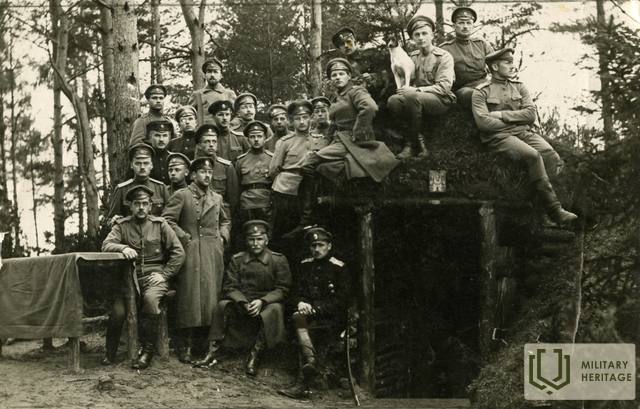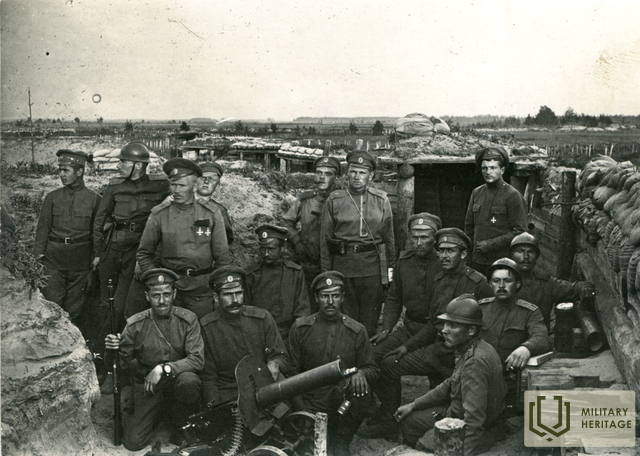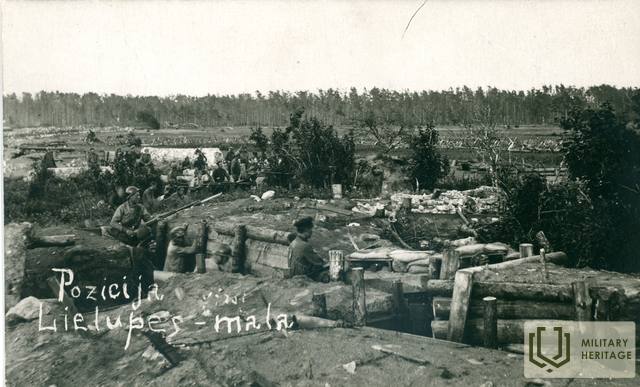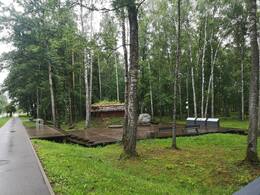About Latvian riflemen in the Olaine area

The memoirs reflect the daily life of Latvian riflemen in the Olaine area. Not only are the living conditions described, but also their usual task - reconnaissance of enemy positions.
(..) We spent the night near the battlefield in artillery bunkers. In the morning we had to go to "Lapsa", near the Olaine station, where we spent a few days and nights under the open sky, in the forest. When we learned that we would have to stay in place for a few more days, we set about building earthen huts energetically. The doors to the dugouts, due to the lack of boards, were made of spruce branches. Wire for the hinges and bricks for the stoves could be obtained in full at the destroyed Olaine station, where, as our Russian neighbors told us, we could not go because the Germans could see and shoot. After about a week we left "Lapsa" and went to the battalion headquarters, which was located near the Baloži station. (..)
(..)As soon as a German rocket appears, even though their trenches are on the other side of the swamp, we lie down. As morning dawns, we split into a thin chain. Our training team is on the right wing of the chain. Before we reach the German trenches, we have to walk for a long time through small bushes covered with snow, with each touch the snow falls behind our collars, our feet sink into the swamp, and the bag of belongings drags our shoulders. As we walk through the bushes, we have to be careful not to stray from each other. All the time we hear machine gun fire on the left wing of the chain, where our company was located. Our artillery also starts working. Bullets also start whizzing towards us. Some whizz past, some explode in front of us, hitting a tree branch. We don't shoot, because we can't see the enemy, but we just move forward. None of the enemy bullets are hiding either. We can start here too, because the "Fritz" are close. The firing began to intensify. Nearby I hear a long drawn-out groan, which leaves a depressing impression amidst the hiss of bullets. One of our comrades has fallen. We quickly undress him; a small hole is visible in his chest, through which new life is flowing out. The second one also falls. I remember a certain farmer from Tukums County, Mūri, who already believed in Latvia and felt the greatest hatred for the Germans. He had disappeared after the battle. Only the following spring did Russian soldiers find his body. Involuntarily I realize how all those who loved the Latvian people the most have all fallen, starting with Briežis and ending with an unknown, unnoticed rifleman. Yes, they had bright souls. We cross a path cut through the forest. We lie down. Some of the braver ones are standing. The Germans have fallen silent. We asked our commander for permission to attack the German trench, but since our company had not been able to break into the German trenches, we were not allowed to do so. We also had no reinforcements. We were just a thin line. We lay on the rope and watched. Here one of our comrades, a brave Courland man who had fallen in the March battle, fired a shot. We saw a German helmet flying over the small birch trees. With another shot, another comrade killed another German. Both Germans were carrying a box of cartridges. Here I saw something moving in the bushes opposite, I told my comrade next to me how to shoot. We both fired at the same time. Immediately the bushes parted and an old German with a bleeding hand appeared, who with his helmet and spiky beard gave the impression of Mephistopheles. He shouted not to shoot, because there were five children at home. We captured him, but it was unnatural to touch him. He was taken away by Russian soldiers. With my comparison, perhaps I am doing him an injustice, perhaps he was an honest family man, detached from his everyday work, but at that moment he left a bad impression. There was also a time later when I was very indignant about the war, seeing the torment of a seriously wounded enemy. But all such moments could only leave a passing impression, because there was a war...
Newspaper “Jēkabpils Vēstnesis”. January 1925.
Related objects
WWI Historical Exploration Route and dugout
Located in Olaine, near the Olaine History and Art Museum.
The historical route was created in 2018 at the site of the Russian army fortifications during World War I, which were part of the area's defense system. The battles between the German and Russian armies in the Olaine area attract attention for several reasons. The swampy terrain prevented the warring parties from achieving quick success and required soldiers to have diverse skills when operating in adverse conditions. Accurate terrain analysis, reconnaissance, and fortifications or engineering structures played a major role in warfare.
Today, the educational route is freely accessible and provides a rough idea of the living conditions of the soldiers. The restored buildings are closed, but can be viewed by contacting the specialists of the Olaine History and Art Museum in advance.
Olaine History and Art Museum
The exhibit in the Olaine History and Art Museum is about the period of Soviet occupation in Olaine. A World War I exploration route with restored elements of the fortifications has been created in the territory of the museum. On the site, where the World War I Russian Army defence line once was, a Russian soldier-type dugout has been built and a fragment of a shooting tower can be viewed by visitors. A World War I reinforced concrete fortification can be seen in Jaunolaine, at the intersection to Plakanciems. During World War I, active battles were fought between the Russian and German armies in this area. Latvian Riflemen units were involved in intelligence and various other operations. Marshy lands made it difficult to defend, but this was a very important area in Latvian military history. Olaine was formed due to the convenient location between Jelgava and Riga, where Jaunolaine is currently located. The Olaine manor was nearby. The modern day Olaine was built during the Soviet occupation, when industrial companies began their operations there.








